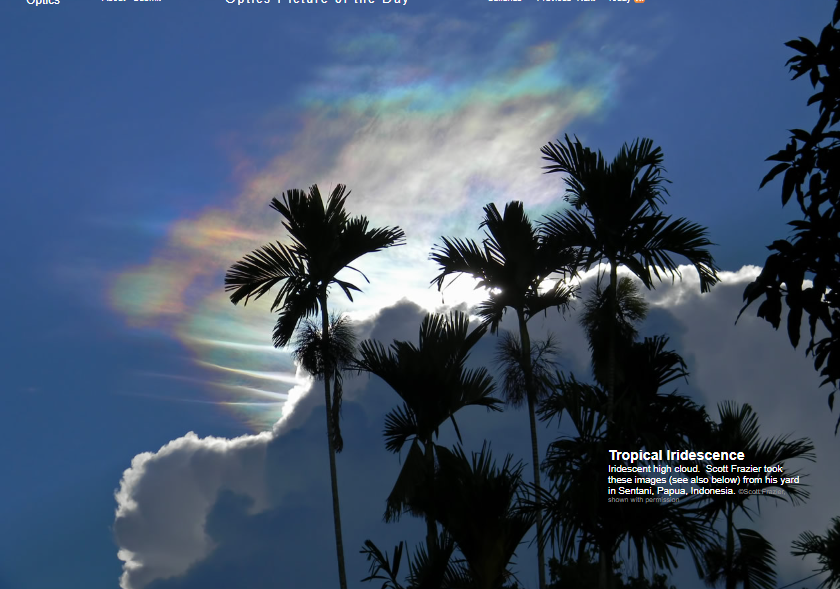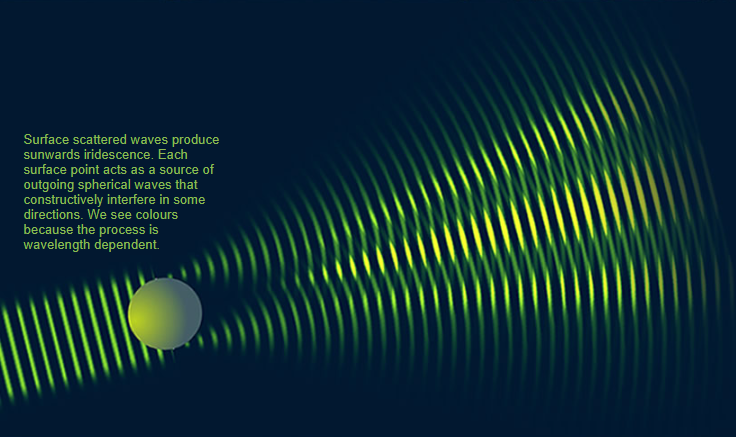OPOD - Tropical Iridescence
OPOD - Tropical Iridescence: A Spectacular Natural Phenomenon
Have you ever witnessed the breathtaking display of colors in the sky known as iridescence? This captivating atmospheric optical phenomenon can often be observed in tropical regions, adding a touch of magic to the already stunning landscapes. In this article, we will delve into the intricacies of tropical iridescence and explore the science behind its mesmerizing appearance.
Iridescence occurs when sunlight interacts with tiny water droplets in the atmosphere, creating a spectacle of vibrant colors. These droplets, ranging in size from 1 to 100 microns, are so small that they diffract incident light waves. As a result, waves scattered from the droplet surfaces act as sources of outgoing spherical waves that interfere constructively in certain directions. This constructive interference leads to the formation of iridescent colors, as different wavelengths of light are reinforced or negated at various angles.
To fully appreciate the beauty of tropical iridescence, it is best to observe it near the sun. However, it is crucial to ensure that the sun is shaded from both eyes to avoid any potential harm. An alternative method to safely view iridescence is by looking at the reflection of the sky in a dark mirror. This allows for a clear and protected view of the stunning display.
A cloud with uniformly sized droplets throughout produces a circular diffraction pattern known as a corona. On the other hand, a cloud with spatially varying droplet sizes gives rise to the less structured colors of iridescence. Despite their different appearances, both phenomena are essentially the same, originating from the diffraction and interference of light waves by water droplets.
The colors observed during tropical iridescence are dependent on the wavelength of light and the angles at which the waves interfere. This dependence gives rise to a wide range of hues, from vibrant blues and greens to delicate pinks and purples. The interplay of sunlight, water droplets, and atmospheric conditions creates a symphony of colors that can leave spectators in awe.
To fully grasp the intricacies of tropical iridescence, it is helpful to understand the underlying science. The phenomenon occurs due to the constructive interference of spherical waves radiating from each point on the surface of the water droplets. These waves overlap and interfere with each other, resulting in the reinforcement or cancellation of specific wavelengths of light. This interference pattern produces the distinct bands of colors observed in iridescence.
It is fascinating to note that tropical iridescence is not limited to high clouds alone. In fact, it can also be observed in various atmospheric conditions, such as thin clouds, fog, or even mist. The presence of these tiny water droplets scattered throughout the atmosphere provides ample opportunities for iridescence to occur, delighting viewers with its ethereal beauty.
In conclusion, tropical iridescence is a natural phenomenon that enchants and captivates observers with its magnificent display of colors. This breathtaking optical phenomenon arises from the interaction between sunlight and tiny water droplets in the atmosphere. The diffraction and interference of light waves by these droplets create a symphony of vibrant hues, adding an extra touch of magic to tropical landscapes. So, keep your eyes peeled and marvel at the wonders of tropical iridescence whenever you find yourself in a region blessed with this extraordinary spectacle.

Tropical Iridescence
Iridescent high cloud. Scott Frazier took these images (see also below) from his yard in Sentani, Papua, Indonesia. ©Scott Frazier, shown with permission

Surface scattered waves produce sunwards iridescence. Each surface point acts as a source of outgoing spherical waves that constructively interfere in some directions. We see colours because the process is wavelength dependent.
Iridescence is best close to the sun. Be sure to shade the sun from both eyes. Viewing the reflection of the sky in a dark mirror is an alternative.
Cloud water droplets are 1 to 100 micron (1/1000 – 1/10 mm) diameter. The smallest are only a few visible light wavelengths across. They significantly diffract incident light waves. Waves scattered from the droplet surface are the main source of a corona or iridescence close to the sun. In effect, spherical waves radiate outwards from each point on the surface. The waves overlap and interfere and light is reinforced in some angles and negated in others. The angles are wavelength dependent giving rise to the iridescent colours.
A cloud with droplets of similar size everywhere across it produces a circular diffraction patter – a corona. Cloud with spatially varying droplet sizes gives the less structured colours of iridescence. The two phenomena are the same.

Note: this article has been automatically converted from the old site and may not appear as intended. You can find the original article here.
Reference Atmospheric Optics
If you use any of the definitions, information, or data presented on Atmospheric Optics, please copy the link or reference below to properly credit us as the reference source. Thank you!
-
<a href="https://atoptics.co.uk/blog/opod-tropical-iridescence/">OPOD - Tropical Iridescence</a>
-
"OPOD - Tropical Iridescence". Atmospheric Optics. Accessed on November 26, 2024. https://atoptics.co.uk/blog/opod-tropical-iridescence/.
-
"OPOD - Tropical Iridescence". Atmospheric Optics, https://atoptics.co.uk/blog/opod-tropical-iridescence/. Accessed 26 November, 2024
-
OPOD - Tropical Iridescence. Atmospheric Optics. Retrieved from https://atoptics.co.uk/blog/opod-tropical-iridescence/.